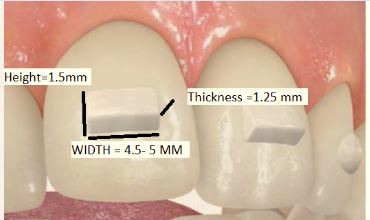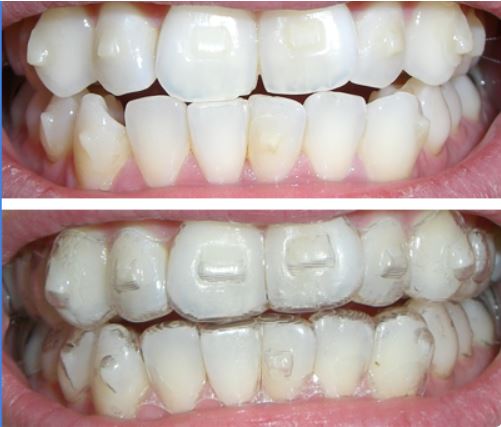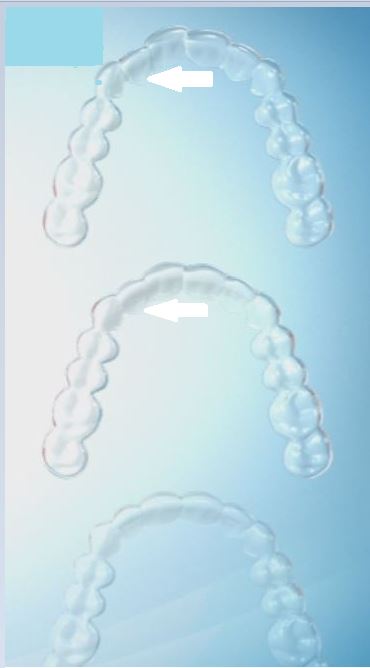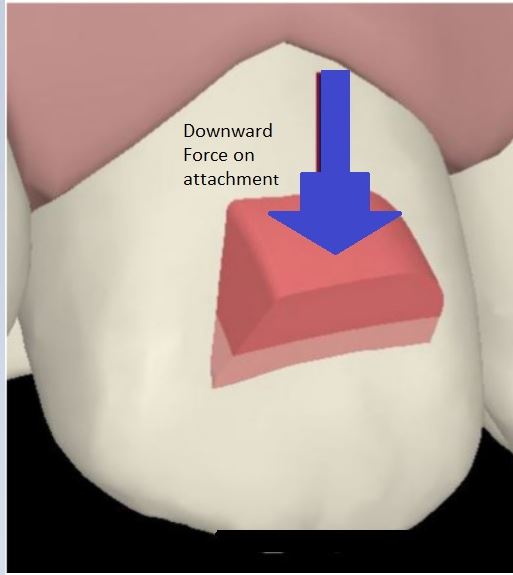(images Courtesy of: http://nobraces.blogspot.com/2012/08/i-got-my-attachments.html)
Invisalign is one type of clear aligner . Align technology who produce invisalign are by far the biggest company in this market. They have an absolutely enormous advertising budget . If you view social media, or watch a TV show , it is likely you will be exposed to an advertisement for some type of plastic aligner that promises a new smile. New patients often enquire about the possibility of straightening their teeth with Invisalign , because they do not want anything stuck to their teeth. Most patients are surprised to learn that although Invisalign doesn’t involve using brackets and wires, it is still necessary to glue tooth coloured “attachments” to the teeth ( as in the pictures above) to improve the ability of aligners to move the teeth. These attachments look somewhat like ceramic brackets.
Why are attachments necessary?
Aligners are a series of plastic shells that attempt to push the teeth into the desired position, as the shape of each sequential aligner covering the teeth moves gradually towards the desired final position. That is the shape of each individual aligner is slightly different.
Attachments serve 2 fundamental purposes
Aligners work by pushing rather than pulling teeth.
- The attachments provide a surface for the plastic of the retainer to push against.
- If the tooth is not to slip out of the aligner, it must be possible for the aligner to grip the teeth. With the back teeth because they are bulbous and have undercuts they may on some occasions provide a natural purchase point for the aligner. The front teeth are however pyramidal in shape , getting narrower towards the biting edge of the tooth. (Imaging trying to grip a wet water melon pip) On these (front) teeth for all movements except pushing the tooth towards the gum (intruding) , attachments are required both to create a pushing surface and to allow the retainer to grip the tooth. Attachments are necessary for rotating, tipping and lengthening the teeth.
If the attachment above was not on the tooth the aligner simply could not provide a downward force to the tooth. Attachments are like handles which the aligner uses when it attempts to move the teeth.
In many ways this arrangement is quite like fixed orthodontic appliances, where you have brackets and a wire, where the bracket or in this case the attachment serve as the handle on the tooth , and the deflected archwire or in this case the distorted aligner then apply a force to move the tooth.
The attachments are made from a tooth coloured composite, the same material which is used to restore broken or carious front teeth.
There are numerous types of aligner attachments. An example of approximate dimensions is illustrated below.
Many tooth movements are impossible without attachments
Some patients are insistent that they don’t want anything bonded to their teeth. Certain tooth movements are unfortunately scientifically impossible without attachments. Imagine trying to make an upper lateral incisor (second tooth from the midline) longer to make it appear straight . If there is not an attachment on this tooth, the aligner will not be able to grip this tooth or have a surface upon which to apply a downward force. Without an attachment because of the pyramidal shape of the tooth the aligner would actually tend to shorten or intrude the tooth. It would be like trying to grip a water melon pip.
Attachments bonded to the teeth are essential to help the aligners to try to move the teeth accurately. A recent article in the American Journal of Orthodontics (2020) July reported that with the use of attachments Invisalign achieved an accuracy of movement of 50%. Previous work by the same author (Dr Neal Kravitz in 2009) from an era when attachments were less widely used found a lower level of accuracy.
Finally it is important that patients are aware of the necessity for attachments before they embark on a course of treatment with aligners , and appreciate that if the number of attachments are scaled back for reasons of patient acceptability, that it will have a very negative effect on the quality of the final result which is achieved.
…………………………………………………………………………………………………..
This orthodontic blog was written by Dr John Buckley ,who is a specialist orthodontist at Clonmel Orthodontics in Clonmel County Tipperary, Ireland.He is both Clonmel’s most qualified and most experienced orthodontist.
Clonmel Orthodontics provides orthodontics to county Tipperary and the neighbouring counties of Waterford, Kilkenny, Limerick,Cork , and beyond.
Dr Buckley has practised as a specialist orthodontist in Clonmel for over 20 years. In addition to his orthodontic qualifications which he held before he commenced orthodontic practice , Dr Buckley was awarded a First class masters degree in Lingual orthodontics from the University of Hannover medical school (MHH) in 2012. This masters degree is directed by Professor Dirk Wiechmann who is the inventor of both the incognito™ and win™ lingual appliances. Dr Buckley was the first orthodontist in Ireland to be awarded this qualification. In 2016 he was accepted as an active member of the European Society Of Lingual Orthodontics (ESLO). To become an active member it is necessary for candidates to submit the records of finished lingual cases. If the cases are deemed to be of a sufficiently high standard then the candidate is accepted as an active member of ESLO. Dr Buckley is the first and only orthodontist in Ireland to be accepted as an active member of ESLO.




